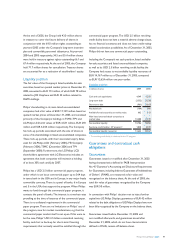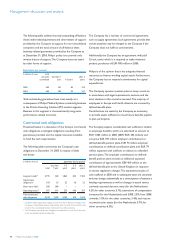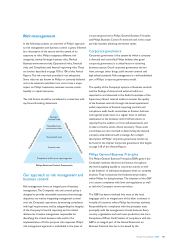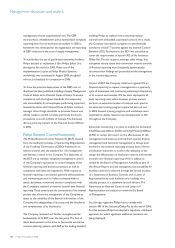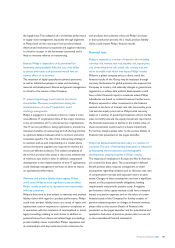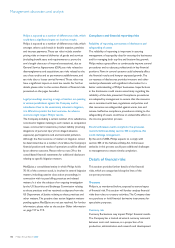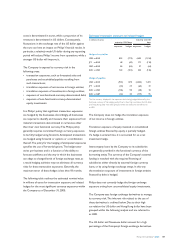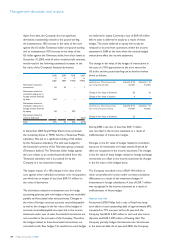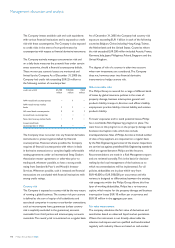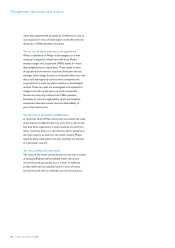Philips 2005 Annual Report Download - page 107
Download and view the complete annual report
Please find page 107 of the 2005 Philips annual report below. You can navigate through the pages in the report by either clicking on the pages listed below, or by using the keyword search tool below to find specific information within the annual report.
Philips Annual Report 2005 107
costs is denominated in euros, while a proportion of its
revenues is denominated in US dollars. Consequently,
fl uctuations in the exchange rate of the US dollar against
the euro can have an impact on Philips’ fi nancial results. In
particular, a relatively weak US dollar during any reporting
period will reduce Philips’ income from operations, while a
stronger US dollar will improve it.
The Company is exposed to currency risk in the
following areas:
transaction exposures, such as forecasted sales and
purchases and receivables/payables resulting from
such transactions;
translation exposure of net income in foreign entities;
translation exposure of investments in foreign entities;
exposure of non-functional-currency-denominated debt;
exposure of non-functional-currency-denominated
equity investments.
It is Philips’ policy that signifi cant transaction exposures
are hedged by the businesses. Accordingly, all businesses
are required to identify and measure their exposures from
material transactions denominated in currencies other
than their own functional currency. The Philips policy
generally requires committed foreign currency exposures
to be fully hedged using forwards. Anticipated transactions
are hedged using forwards or options or a combination
thereof. The policy for the hedging of anticipated exposures
specifi es the use of forwards/options. The hedge tenor
varies per business and is a function of the ability to
forecast cashfl ows and the way in which the businesses
can adapt to changed levels of foreign exchange rates, as
a result hedging activities may not eliminate all currency
risks for these transaction exposures. Generally, the
maximum tenor of these hedges is less than 18 months.
The following table outlines the estimated nominal value
in millions of euros for transaction exposure and related
hedges for the most signifi cant currency exposures within
the Company as of December 31, 2005:
•
•
•
•
•
Estimated transaction exposure and related hedges
in millions of euros
maturity 0-60 days
m aturity over 60
days
exposure hedges exposure hedges
Hedges of receivables
USD vs EUR 822 (775 ) 4,402 (1,744 )
JPY vs EUR 48 (40 ) 171 (118 )
GBP vs EUR 84 (84 ) 97 (64 )
EUR vs USD 122 (105 ) 234 (146 )
Hedges of payables
USD vs EUR (933 ) 878 (3,245 ) 1,201
JPY vs EUR (30 ) 29 (60 ) 39
EUR vs USD (106 ) 98 (28 ) 18
EUR vs GBP (32 ) 30 (119 ) 95
The fi rst currency displayed is the exposure that is being hedged followed by the
functional currency of the hedging entity. Due to their high correlation the US dollar
and Hong Kong dollar have been grouped within the table and are referred to
as USD.
The Company does not hedge the translation exposure
of net income in foreign entities.
Translation exposure of equity invested in consolidated
foreign entities fi nanced by equity is partially hedged.
If a hedge is entered into, it is accounted for as a net
investment hedge.
Intercompany loans by the Company to its subsidiaries
are generally provided in the functional currency of the
borrowing entity. The currency of the Company’s external
funding is matched with the required fi nancing of
subsidiaries either directly by external foreign currency
loans, or by using foreign exchange swaps. In this way
the translation exposure of investments in foreign entities
fi nanced by debt is hedged.
Philips does not currently hedge the foreign exchange
exposure arising from unconsolidated equity investments.
The Company uses foreign exchange derivatives to manage
its currency risk. The inherent risk related to the use of
these derivatives is outlined below. Due to their high
correlation the US dollar and Hong Kong dollar have been
grouped within the following analysis and are referred to
as USD.
The US dollar and Taiwanese dollar account for a high
percentage of the Company’s foreign exchange derivatives.


